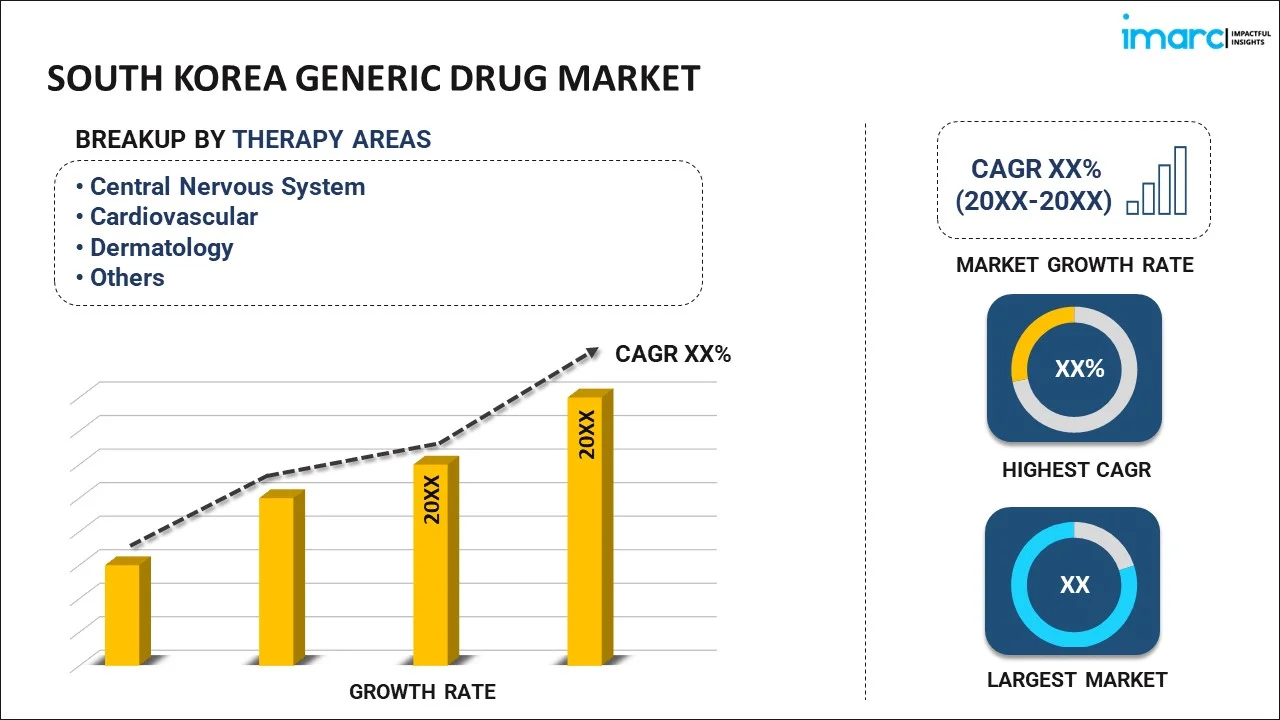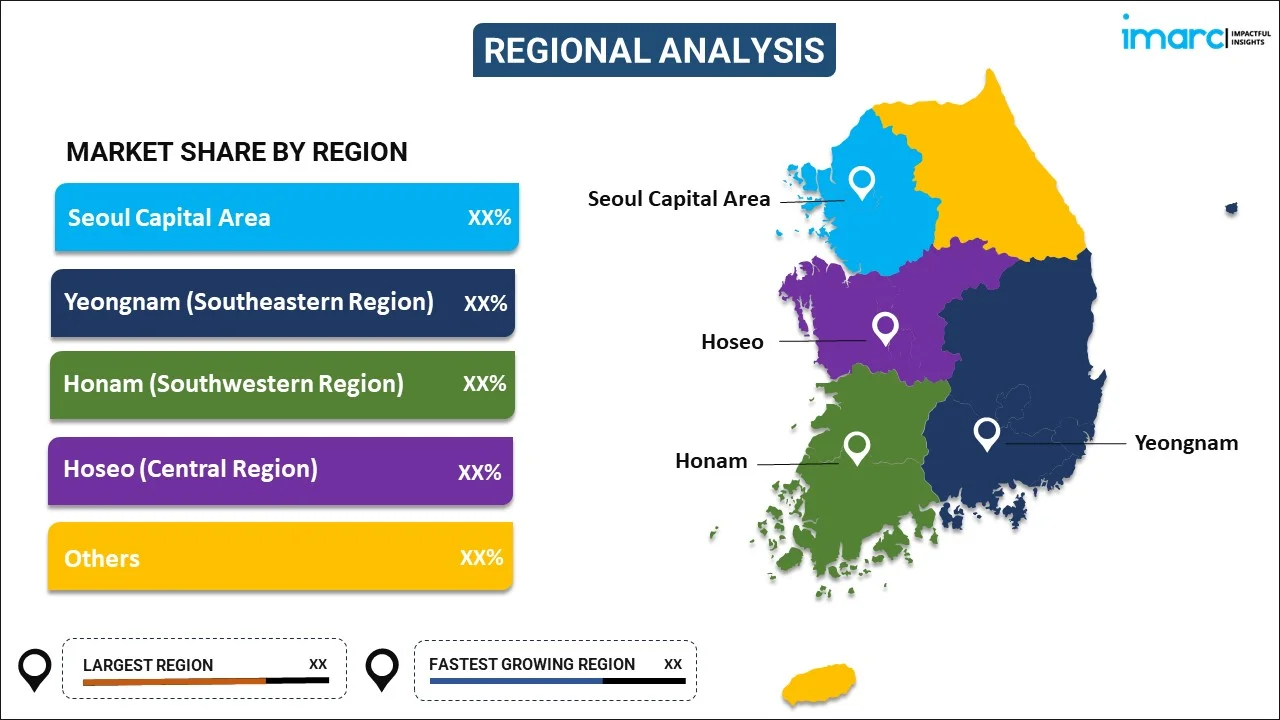
South Korea Generic Drug Market Report by Therapy Area (Central Nervous System, Cardiovascular, Dermatology, Genitourinary/Hormonal, Respiratory, Rheumatology, Diabetes, Oncology, and Others), Drug Delivery (Oral, Injectables, Dermal/Topical, Inhalers), Distribution Channel (Retail Pharmacies, Hospital Pharmacies), and Region 2026-2034
Market Overview:
South Korea generic drug market size reached USD 7.7 Billion in 2025. Looking forward, IMARC Group expects the market to reach USD 10.4 Billion by 2034, exhibiting a growth rate (CAGR) of 3.46% during 2026-2034. The implementation of favorable government initiatives, the expiration of various branded medicines, the expanding pharmaceutical industry in the country, and the escalating demand for affordable treatment plans represent some of the key factors driving the market.
|
Report Attribute
|
Key Statistics
|
|---|---|
|
Base Year
|
2025
|
|
Forecast Years
|
2026-2034
|
|
Historical Years
|
2020-2025
|
|
Market Size in 2025
|
USD 7.7 Billion |
|
Market Forecast in 2034
|
USD 10.4 Billion |
| Market Growth Rate 2026-2034 | 3.46% |
Access the full market insights report Request Sample
A generic drug is a pharmaceutical product that is equivalent to a brand-name or innovator drug in terms of its active ingredients, dosage, safety, efficacy, and intended use. However, it is typically marketed and sold under its chemical or generic name, rather than the brand name that was initially patented by the drug's manufacturer. The dosage form, strength, and route of administration of a generic drug are the same as the brand-name drug, ensuring consistent and predictable therapeutic outcomes. To be approved as a generic drug, it must demonstrate bioequivalence to the brand-name drug. This means that the generic drug must have the same rate and extent of absorption in the body as the brand-name drug, leading to similar therapeutic effects. Generic drugs are typically more affordable than brand-name drugs. This cost savings is often a result of competition in the pharmaceutical market after the expiration of the patent on the brand-name drug. Once a brand-name drug's patent expires, other pharmaceutical companies can produce and market generic versions of the drug. This competition leads to lower prices for consumers.
South Korea Generic Drug Market Trends:
The South Korean government has implemented various policies and initiatives to promote the use of generic drugs as a means to reduce healthcare costs and enhance the affordability of medications. These policies include incentivizing physicians to prescribe generics, promoting generic substitution at pharmacies, and implementing pricing mechanisms that encourage the use of generic medications. In addition, the escalating cost of healthcare services and medications has become a significant concern in South Korea. To address this issue, both the government and healthcare providers are increasingly turning to generic drugs as cost-effective alternatives to brand-name medications. This cost-conscious approach has led to a growing preference for generic prescriptions. Besides, South Korea, like many other countries, has an aging population. With the elderly being more susceptible to chronic illnesses and requiring long-term medication, there is a greater need for affordable treatment options. Generic drugs provide a cost-effective solution for managing chronic conditions, such as hypertension, diabetes, and cardiovascular diseases. Moreover, the pharmaceutical industry has been expanding and becoming increasingly competitive. Domestic generic drug manufacturers are investing in research and development to produce high-quality generic medications. This growth in the local pharmaceutical sector has led to a wider range of generic drug options for healthcare providers and consumers. Furthermore, healthcare professionals in South Korea are becoming more aware of the safety and efficacy of generic drugs. They are increasingly inclined to prescribe generic medications when appropriate, which helps boost the acceptance and utilization of generics among patients.
South Korea Generic Drug Market Segmentation:
IMARC Group provides an analysis of the key trends in each segment of the market, along with forecasts at the country level for 2026-2034. Our report has categorized the market based on therapy area, drug delivery, and distribution channel.
Therapy Area Insights:

To get detailed segment analysis of this market Request Sample
- Central Nervous System
- Cardiovascular
- Dermatology
- Genitourinary/Hormonal
- Respiratory
- Rheumatology
- Diabetes
- Oncology
- Others
The report has provided a detailed breakup and analysis of the market based on the therapy area. This includes central nervous system, cardiovascular, dermatology, genitourinary/hormonal, respiratory, rheumatology, diabetes, oncology, and others.
Drug Delivery Insights:
- Oral
- Injectables
- Dermal/Topical
- Inhalers
A detailed breakup and analysis of the market based on the drug delivery have also been provided in the report. This includes oral, injectables, dermal/topical, and inhalers.
Distribution Channel Insights:
- Retail Pharmacies
- Hospital Pharmacies
The report has provided a detailed breakup and analysis of the market based on the distribution channel. This includes retail pharmacies and hospital pharmacies.
Regional Insights:

To get detailed regional analysis of this market Request Sample
- Seoul Capital Area
- Yeongnam (Southeastern Region)
- Honam (Southwestern Region)
- Hoseo (Central Region)
- Others
The report has also provided a comprehensive analysis of all the major regional markets, which include Seoul Capital Area, Yeongnam (Southeastern Region), Honam (Southwestern Region), Hoseo (Central Region), and Others.
Competitive Landscape:
The market research report has also provided a comprehensive analysis of the competitive landscape in the market. Competitive analysis such as market structure, key player positioning, top winning strategies, competitive dashboard, and company evaluation quadrant has been covered in the report. Also, detailed profiles of all major companies have been provided.
South Korea Generic Drug Market Report Coverage:
| Report Features | Details |
|---|---|
| Base Year of the Analysis | 2025 |
| Historical Period | 2020-2025 |
| Forecast Period | 2026-2034 |
| Units | Billion USD |
| Scope of the Report | Exploration of Historical Trends and Market Outlook, Industry Catalysts and Challenges, Segment-Wise Historical and Future Market Assessment:
|
| Therapy Areas Covered | Central Nervous System, Cardiovascular, Dermatology, Genitourinary/Hormonal, Respiratory, Rheumatology, Diabetes, Oncology, Others |
| Drug Deliveries Covered | Oral, Injectables, Dermal/Topical, Inhalers |
| Distribution Channels Covered | Retail Pharmacies, Hospital Pharmacies |
| Regions Covered | Seoul Capital Area, Yeongnam (Southeastern Region), Honam (Southwestern Region), Hoseo (Central Region), Others |
| Customization Scope | 10% Free Customization |
| Post-Sale Analyst Support | 10-12 Weeks |
| Delivery Format | PDF and Excel through Email (We can also provide the editable version of the report in PPT/Word format on special request) |
Key Questions Answered in This Report:
- How has the South Korea generic drug market performed so far and how will it perform in the coming years?
- What has been the impact of COVID-19 on the South Korea generic drug market?
- What is the breakup of the South Korea generic drug market on the basis of therapy area?
- What is the breakup of the South Korea generic drug market on the basis of drug delivery?
- What is the breakup of the South Korea generic drug market on the basis of distribution channel?
- What are the various stages in the value chain of the South Korea generic drug market?
- What are the key driving factors and challenges in the South Korea generic drug?
- What is the structure of the South Korea generic drug market and who are the key players?
- What is the degree of competition in the South Korea generic drug market?
Key Benefits for Stakeholders:
- IMARC’s industry report offers a comprehensive quantitative analysis of various market segments, historical and current market trends, market forecasts, and dynamics of the South Korea generic drug market from 2020-2034.
- The research report provides the latest information on the market drivers, challenges, and opportunities in the South Korea generic drug market.
- Porter's five forces analysis assist stakeholders in assessing the impact of new entrants, competitive rivalry, supplier power, buyer power, and the threat of substitution. It helps stakeholders to analyze the level of competition within the South Korea generic drug industry and its attractiveness.
- Competitive landscape allows stakeholders to understand their competitive environment and provides an insight into the current positions of key players in the market.
Need more help?
- Speak to our experienced analysts for insights on the current market scenarios.
- Include additional segments and countries to customize the report as per your requirement.
- Gain an unparalleled competitive advantage in your domain by understanding how to utilize the report and positively impacting your operations and revenue.
- For further assistance, please connect with our analysts.
 Request Customization
Request Customization
 Speak to an Analyst
Speak to an Analyst
 Request Brochure
Request Brochure
 Inquire Before Buying
Inquire Before Buying




.webp)




.webp)












